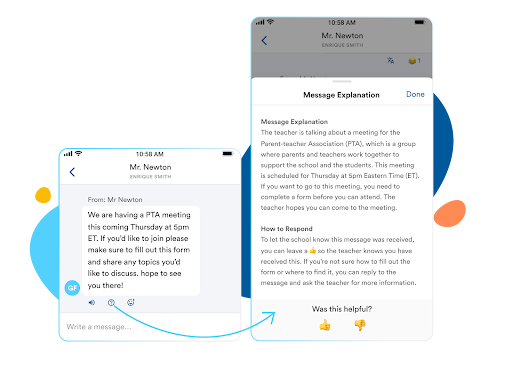Written by Paige DeLozier
Nearly 1 in 4 students in U.S. schools speak a language other than English at home. For teachers, that can mean real challenges when trying to engage families. TalkingPoints goes beyond translation—helping you craft clear, effective messages that reach every family, in every language.
We continually strive to offer a more efficient and effective channel of communication for teachers and families. Accurate translation into 150 languages is an essential part of that work.
Why translation in family-school communication matters
Educators nationwide are greeting classrooms filled with multilingual students, and they want to connect with their families, but a language barrier often prevents deep, meaningful engagement. TalkingPoints founder and CEO, Heejae Lim, experienced this herself when she was an English Language Learner, watching her mother and other parents struggle to connect with the teacher.
That’s why part of our barrier-breaking mission has always included the highest-quality two-way enhanced translation for families and schools. We continually develop new ways to expand support for multilingual school-family engagement.
8 translation tips for engaging every family
When writing for a multilingual audience, certain expressions don’t always translate the way intended. The original text serves as a base for content in other languages. Therefore, the message in the original language must be written as clearly as possible because it will impact the translations. To avoid confusion, here are some tips to keep in mind when crafting your TalkingPoints messages.
- Write short, simple sentences
- Use proper grammar
- Avoid specialized language
- Decide what will stay in English
- Be specific
- Use active voice
- Utilize visuals
- Know how international dates are formatted
1. Write short, simple sentences
Writing long sentences in English will complicate the translation process and increase the chance of confusion (especially given the varying literacy levels of families). Keeping texts simple and concise fosters more effective communication. For these reasons, we have the readability flag feature, which notifies teachers when a sentence is likely too complex for non-English speakers.

2. Use proper grammar
Because mistakes can travel from the original language to target languages, ensure correct grammatical structure and proper punctuation.
For example, these errors can lead to incorrect translation and cause confusion:
- Run-on sentence: Johnny was late today, what time did he leave for school, did you know that he has been late three times this week already.
- Correction: Johnny was late today. What time did he leave for school? He has been late three times this week.
- Lack of capitalization: Hi all–please remember that we are joining st. paul middle for the excursion to the museum of Natural History tomorrow. We will meet in the downstairs lobby.
- Correction: Hi all–please remember that we are joining St. Paul Middle School for the excursion to the Museum of Natural History tomorrow. We will meet in the downstairs lobby.
3. Avoid specialized language
- Idioms- Idioms such as “beat around the bush” may have a clear meaning in English, but most likely will not in other languages.
- Acronyms- Abbreviations will most likely have different letters for the words they represent in other languages. It is best to spell these words out for accurate translation.
- Professional jargon and colloquial terms- Medical, legal and other professional jargon, regional phrases, and figures of speech rarely translate with equivalency. It’s best to use clear, simple language to avoid misunderstandings.

Teachers, encourage parents and guardians with smartphones to download the TalkingPoints for Families app to access support features like those mentioned above.
4. Decide what will stay in English
Some information needs to stay in English to avoid confusion. Although we recommend keeping this to a minimum (no more than twice per message), utilizing curly braces will keep texts from being translated in TalkingPoints.
- Place names: During the field trip, we’ll stop at {Boston Common} for a break, before continuing to {Old North Church}.
- Addresses: If you’d prefer, you can mail the signed form to {1234 Summer Street, City, State Zip}.
- Homework assignments: Tonight, students should complete the {Silly Synonyms Worksheet}.
- People’s names: Hi, my name is {Joy Summer}, I will be your child’s 4th grade teacher this year.
5. Be specific
Words with multiple connotations can be confusing in other languages. It’s best to avoid words with various meanings and use specific vocabulary to describe situations.
Vague wording
- Jenny was acting silly in class today and distracting the other students.
- Jenny made a silly drawing in class today, and everyone loved it!
The word “silly” has positive and negative connotations, such as being funny or rambunctious. It’s better to use a word that specifically describes Jenny’s actions.
Correction
- Jenny was disruptive in class today and distracted the other students.
- Jenny made a funny drawing in class today, and everyone loved it!
6. Use active voice
Sentences in the active voice have a strong, direct, and clear tone. Using an active voice relates a transparent, assertive message.
- Active Voice ✅ Brett did his assignment.
- Passive Voice ❌The assignment was done by Brett.
- Active Voice ✅ I am here to answer any questions you have.
- Passive Voice ❌ Any questions you have will be answered by me.
7. Include visuals
Providing visuals of what is being translated can increase comprehension and understanding from message recipients. At times, a picture or video can make a huge difference in connecting with families.

8. Know how international dates are formatted
In the U.S., dates are written as the month, day, and year.
- Example: 09/07/2021.
In other countries, dates are written as the day, month, and year.
- Example: 07/09/2021
Families who are not as familiar with the US format could confuse one for the other. For accuracy, it’s best to spell out the name of the month and then put the date. If space is tight, using an abbreviation for the month is fine too.
- Example: September 7, 2021 or Sep. 7, 2021
![]()
See TalkingPoints in action—watch a 90-second explainer video.
![]()
Celebrating 10 years of partnership and impact
For a decade, TalkingPoints has supported students, families, and educators through the power of effective family-school partnerships. As an education technology nonprofit, our award-winning communication and family engagement platform has improved outcomes for districts and students across the country.
We connect 9 million+ educators, students, and family members annually and have facilitated more than one billion conversations—building trust, fostering relationships, and fueling student success. Named by Common Sense Education as “the best overall family communication platform for teachers and schools,” TalkingPoints drives measurable gains in attendance and academic achievement, backed by rigorous, causal research.
Join us in building a future where every child has the support they need to thrive.



